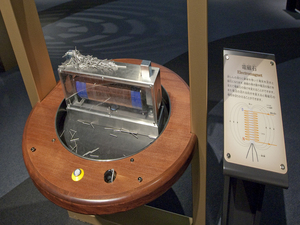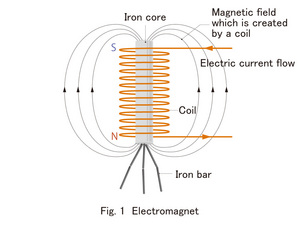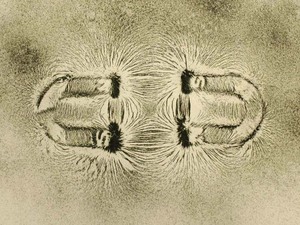Nagoya City Science Museum
TOP > Exhibition Guide > Keyword Search > Starting with "M" > magnetic field > Electromagnet
Electromagnet



Purpose of Exhibition
While experiencing the current strength of the magnet, you can understand the relationship between electricity and magnets.
Additional Knowledge
In the exhibition, there are things called "electromagnets".
Wire is wrapped around cast iron, which is called a coil. When current flows through the coil, it becomes a strong magnet. When reversing the direction of the current, the direction of the N or S pole shifts.
[Relationship between electricity and magnets]
Both are closely related to each other. In 1820, a Danish physicist, Hans Christian _rsted discovered that electricity and magnets are related by needles moving when a compass is placed near electric wires. This can still be carried out in a simple experiment. When you place the wire on the compass, the needle tries to be at a right angle to the electric wires. If you place the compass on the electric wires, you can recognize that the needles move in reverse compared with placing the compass under the electric wires.
[Beginning of electromagnets]
A strong magnetic force cannot generate with one wire, but as many wires wound into a coil, one around the other, the electromagnetic power can be brought together, creating strong magnets. Electricity flows through the coil wired at both ends, which become the N and S poles.
A magnetic coil with nothing in the center also generates electromagnetic power, but you can generate a stronger magnetic field with the use of an iron core, because it can concentrate the magnetic force generated in the coil.
The first magnet, a horseshoe-shaped iron wound wire, was created in 1820 by a British man, William Sturgeon.
[Electromagnets and magnets]
The main difference between electromagnets and magnets is that the magnetic force can be varied by controlling the current.
If a strong current flows, it becomes a strong magnet. You can stop the magnetic force by stopping the current. A magnet cannot alter the magnetic force.
The magnetic force varies using the electromagnet, and you can also carry things.
[Lines of magnetic force]
Magnetic force lines are imaginary lines from the N pole to the S pole.
This is useful when considering the magnetic line strength and direction. Place a piece of paper on a magnet, and when you pour iron sand on it, it creates a pattern by surrounding the magnet.
It closely matches the pattern of magnetic field lines.
The compass is pointing in the direction of the earth's magnetic field lines.
In the exhibit, there are a number of thin iron bars, and when attached to electromagnets, the bars are connected facing toward the direction of a line of magnetic power. In the line of magnetic power, the N pole and the S pole are connected, and the bars are linked for uniting the N pole with the S pole. In the exhibit, you can change the direction of electricity by rotating the N pole and the S pole in reverse, and you can recognize by the way the bars are sticking as to how the flow of the line of magnetic power has changed. A line of magnetic power never fails to stick to each other when uniting the N pole and the S pole; it will not unit the same poles, like the N pole and the N pole and the S pole and the S pole.
Article by Yoshitaka Yamada, curator
